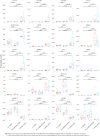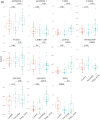Transcriptomics unravels molecular changes associated with cilia and COVID-19 in chronic rhinosinusitis with nasal polyps
- PMID: 37085563
- PMCID: PMC10121071
- DOI: 10.1038/s41598-023-32944-3
Transcriptomics unravels molecular changes associated with cilia and COVID-19 in chronic rhinosinusitis with nasal polyps
Abstract
Chronic rhinosinusitis with nasal polyps (CRSwNP) is a common upper respiratory tract complication where the pathogenesis is largely unknown. Herein, we investigated the transcriptome profile in nasal mucosa biopsies of CRSwNP patients and healthy individuals. We further integrated the transcriptomics data with genes located in chromosomal regions containing genome-wide significant gene variants for COVID-19. Among the most significantly upregulated genes in polyp mucosa were CCL18, CLEC4G, CCL13 and SLC9A3. Pathways involving "Ciliated epithelial cells" were the most differentially expressed molecular pathways when polyp mucosa and non-polyp mucosa from the same patient was compared. Natural killer T-cell (NKT) and viral pathways were the most statistically significant pathways in the mucosa of CRSwNP patients compared with those of healthy control individuals. Upregulated genes in polyp mucosa, located within the genome-wide associated regions of COVID-19, included LZTFL1, CCR9, SLC6A20, IFNAR1, IFNAR2 and IL10RB. Interestingly, the second most over-expressed gene in our study, CLEC4G, has been shown to bind directly to SARS-CoV-2 spike's N-terminal domain and mediate its entry and infection. Our results on altered expression of genes related to cilia and viruses point to the de-regulation of viral defenses in CRSwNP patients, and may give clues to future intervention strategies.
© 2023. The Author(s).
Conflict of interest statement
The authors declare no competing interests.
Figures










Similar articles
-
Role of IFN-γ, IL-13, and IL-17 on mucociliary differentiation of nasal epithelial cells in chronic rhinosinusitis with nasal polyps.Clin Exp Allergy. 2016 Mar;46(3):449-60. doi: 10.1111/cea.12644. Clin Exp Allergy. 2016. PMID: 26399381
-
Single-cell RNA sequencing reveals the epithelial cell, fibroblast, and key gene alterations in chronic rhinosinusitis with nasal polyps.Sci Rep. 2024 Jan 27;14(1):2270. doi: 10.1038/s41598-024-52341-8. Sci Rep. 2024. PMID: 38280891 Free PMC article.
-
Enhanced expression of SAM-pointed domain-containing Ets-like factor in chronic rhinosinusitis with nasal polyps.Laryngoscope. 2015 Mar;125(3):E97-103. doi: 10.1002/lary.25008. Epub 2014 Nov 6. Laryngoscope. 2015. PMID: 25376946
-
Cytokine Signature and Involvement in Chronic Rhinosinusitis with Nasal Polyps.Int J Mol Sci. 2021 Dec 30;23(1):417. doi: 10.3390/ijms23010417. Int J Mol Sci. 2021. PMID: 35008843 Free PMC article. Review.
-
A Comprehensive Systematic Review of the Association Between Airway Mucins and Chronic Rhinosinusitis.Am J Rhinol Allergy. 2019 Jul;33(4):433-448. doi: 10.1177/1945892419837042. Epub 2019 Mar 20. Am J Rhinol Allergy. 2019. PMID: 30892914 No abstract available.
Cited by
-
Characterization of the Immune Microenvironment and Identification of Biomarkers in Chronic Rhinosinusitis with Nasal Polyps Using Single-Cell RNA Sequencing and Transcriptome Analysis.J Inflamm Res. 2024 Jan 12;17:253-277. doi: 10.2147/JIR.S440409. eCollection 2024. J Inflamm Res. 2024. PMID: 38229690 Free PMC article.
References
Publication types
MeSH terms
Substances
LinkOut - more resources
Full Text Sources
Medical
Miscellaneous

